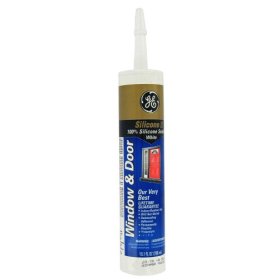Cities With the Highest Percentage of Millionaires
Phoenix Marketing International just released a study and found that New Mexico’s Los Alamos has the highest concentration of millionaires living in one city. Almost 1 in 10 residents of Los Alamos is a millionaire! Think about that, at any one point in time, almost every store in the local mall probably has a millionaire in it (assuming there is an average of 10 customers in each store).
Here’s are the top 10 cities with the highest percentage of millionaires:
.
| City | Millionaires |
|---|---|
| Los Alamos, N.M. | 9.7% |
| Naples/Marco Island, Fla. | 8.6% |
| BridgePort/Stamford/Norwalk, Conn. | 7.2% |
| Vero Beach, Fla. | 7.2% |
| San Jose/Sunnyvale, Calif. | 6.9% |
| Sarasota/Bradenton/Venica, Fla. | 6.7% |
| align=”left”Easton, Md. | 6.7% |
| Hilton Head Island/Beaufort, S.C. | 6.6% |
| San Francisco/Oakland, Calif. | 6.4% |
| Honolulu, Hawaii | 6.4% |
.
Permalink to this article Discussions (2)
Free LandlordMax Real Estate Property Analyzer Online Tool is Now Available!
I’m very excited to announce that last night we launched a new and FREE real estate property analyzer online tool on LandlordMax. This is a great tool, and I would wager the most in-depth tool of this type that you can find online! It doesn’t just create a simple amortization table for you, it creates 7 major reports, including: Amortization Table, Yearly Income Versus Expenses, Yearly Cash Flow, Property Appreciation Versus Debt, Cash on Cash Return, Net Operating Income (NOI), and Debt Coverage Ratio.
What’s really great about this tool is that it also takes into consideration several variables that you enter when calculating all of the reports, variables such as vacancy rate, annual property appreciation rate, annual income/expense growth rates, and so on. It also gives you the option to put in one time capital expenditures, custom yearly expenses, and so on.
As you can see, this is an in-depth real estate property analyzer, especially considering it’s free!
I’d also like to take a minute to thank everyone who’s helped us test it. As well, I’d like to especially thank two individuals who provided me with exceptional feedback. They are Glenn Scott (a local real estate investor and founder of Symbiotic.com) and Albert Boudreau (founder of Ideal Property Management). Thank you!
Please let me know what you think of it. If you have any comments or feedback, I’d be more than happy to hear about it. And don’t forget to let your fellow real estate investors know about it!
The link is: https://www.landlordmax.com/real-estate-analyzer
Permalink to this article Discussions (2)
10 Questions to Ask When Choosing Your Real Estate Agent
 There’s an interesting little article on the Dumb Little Man blog listing 10 questions he recommends you ask your real estate agent before choosing them. Each question comes with the standard answer you will likely get from the agent, as well as a “Tip” on how to probe deeper and what answer you really want to hear. Although I agree that they are all good questions, I don’t know that I’d ask each and every one of them myself. In any case, it’s definitely worth reading.
There’s an interesting little article on the Dumb Little Man blog listing 10 questions he recommends you ask your real estate agent before choosing them. Each question comes with the standard answer you will likely get from the agent, as well as a “Tip” on how to probe deeper and what answer you really want to hear. Although I agree that they are all good questions, I don’t know that I’d ask each and every one of them myself. In any case, it’s definitely worth reading.
Permalink to this article Discussions (0)
Local Ottawa City Contractor
Normally I avoid recommending local contractors because of the potential downside (will they continue to provide quality work, etc.) but today I’m going to make an exception. I’m giving a public recommendation to Elgin from Elgin Eden Contracting. Just a quick tip though, if you need work done call him sooner than later because he’s generally very busy and therefore has a waiting period. If you’re in the local Ottawa region you can get a hold of him at: (613) 858-9034.
Permalink to this article Discussions (0)
An Ounce of Prevention Really is Worth a Pound of Cure
I again re-learned from first-hand experience that an ounce of prevention really is worth a pound of cure. How? Two of the windows to my own house leaked because the caulking had gotten old and cracked which caused water to leak in. The water saturated some of the framing wood, caused a lot of mold (in no time at all might I add), and basically ended up with two half walls being replaced to get at the problem. A very expensive lesson to learn again.
For those of you who read this blog regularly, you know that I’ll look at the numbers to really see if the cost of the prevention really outweighed the cost of the repairs. So let’s not waste anymore time and look at them right away.
Since the costs for the repairs can fluctuate quite a bit, I’ll make a worse and best case scenario. In the best case scenario, which luckily pretty much happened for me, you won’t need to replace the actual windows (especially if they’re higher-end windows), much of the framing, any of the flooring, etc. The worse case is that everything is completely water saturated and full of mold. In my particular case, in both rooms only the framing below the windows was saturated with water and mold. The rest of the framing, the flooring, and the windows were all ok. So what’s the total cost? Seeing as I had to rip open two walls, replace some framing, etc., a round number of $1000 for labour and materials is easy to achieve. This could however easily climb to $5,000 – $10,000 if new windows need replacing, if the floor is finished, if the water damage spread to the floor below, etc. So let’s assume a small round number of $2,500. Is the prevention worth $2,500?
I quickly went to Amazon.com and looked at the price of caulking where one tube of GE Silicone II caulking will set you back $6.89. Assuming this price, for $2,500 you can buy 362 tubes of caulking. For a standard sized house, I can’t see anyone using more than 10 tubes of caulking (including windows, doors, vents, etc.). Going further, let’s assume we need to caulk every 3 years (this is aggressive, generally you do it every 4-7 years). Looking at the numbers:
$2,500 / $6.89 = 362 tubes of caulking
362 / 10 tubes per session = 36 caulking sessions
36 caulking session * 3 years in-between each session = 108 years of caulking and leak free windows!
Therefore we could have spent that same money we did on repairs and bought caulking for almost 2 full lifetimes and saved ourselves from all leaks in the future (well at least all leaks due to bad caulking) in our lifetime. So yes, in this case, an ounce of prevention is really truly worth a pound of cure!
Permalink to this article Discussions (1)
Common Real Estate Ad Terms and Their Relationship to Selling Price
 Those of us who have dealt with the real estate market, we are all too familiar with the many terms used to describe a real estate property. Terms like “spacious”, “state of the art”, “charming”, etc., they all bring up different mindsets. To the untrained real estate investor, these terms can be confusing. However over time you start to get an understanding of what they really mean. For example, a “great neighborhood” often means that the houses in the neighborhood are nicer than the one being sold. No one will go out and say they’re selling you the ugliest house on the block, rather they’ll put a positive spin, such as you have a great neighborhood.
Those of us who have dealt with the real estate market, we are all too familiar with the many terms used to describe a real estate property. Terms like “spacious”, “state of the art”, “charming”, etc., they all bring up different mindsets. To the untrained real estate investor, these terms can be confusing. However over time you start to get an understanding of what they really mean. For example, a “great neighborhood” often means that the houses in the neighborhood are nicer than the one being sold. No one will go out and say they’re selling you the ugliest house on the block, rather they’ll put a positive spin, such as you have a great neighborhood.
In any case, in the book Freakonomics, they did a detailed study of the many words used to describe real estate properties and they found strong correlations between the words used in the ads and the selling price of the properties. Now before I go on, please note that correlation means that the two items are related but it doesn’t mean that one causes the other. So for example, there is a correlation that cars painted yellow get in fewer acccidents. Does this mean that if you paint your car yellow you’re less likely to get into a car accident? Not at all. One does not explain the other. You have to look at other factors. In this particular example, the reason that yellow painted cars get into fewer accidents is because of the type of person who buys and drives a yellow car rather than just the color of the car.
Getting back to words that describe real estate properties, it’s been found that the 10 most common used in real estate ads do have strong correlations to the selling price.
Top Five Terms With Higher Selling Prices
Granite
State of the art
Corian
Maple
Gourmet
Top Five Terms With Lower Selling Prices
Fantastic
Spacious
!
Charming
Great Neighborhood
Very interesting! Why do these specific terms have strong correlations with higher or lower selling prices? The book goes on to debate this, and I’m sure some of them are obvious once you start to think about it. However for today what’s interesting to note is that the words in your real estate ad will ultimately affect your selling price.
Again, I strongly recommend the book Freakonomics. There’s lots of great information on many a topic, not just real estate. If you’re interested, you can buy a copy here through this Amazon.com link.
Permalink to this article Discussions (4)
Interesting Statistics About Real Estate Agents
 I’ve been reading another interesting book called Freakonomics over the last week which is filled with lots of facts and great explanations behind them. In my next article I’ll even write about another real estate related metric I found in the book. But for now, heres today’s tidbit:
I’ve been reading another interesting book called Freakonomics over the last week which is filled with lots of facts and great explanations behind them. In my next article I’ll even write about another real estate related metric I found in the book. But for now, heres today’s tidbit:
Real estate agents keep their own properties on the market an average of 10 days longer and sell them for an extra 3+%. To quote the book, on a house of $300,000, that means they sell it for an extra $10,000.
Freakonomics goes into more details as to the cause, and it’s nothing negative against the real estate agent. It’s simply all about incentives, and it makes perfect sense once you understand the facts. So let’s take a quick look.
Looking at that same $300,000 property again, after breaking up the commission, etc., the real estate agent’s average take is $4,500, or about 1.5% of the total purchase price. Now if we take a $310,000 property (adding the $10,000 difference), the real estate agent’s additional 1.5% revenue on $10,000 comes to a total of $150. Therefore the question is, is it worth it for the real estate agent to work an 10 additional days (have more showings, consume a lot of time, take away time from selling other properties, etc.) for $150? I agree with the author, probably not, the incentive just isn’t there. Would you work an additional 10 days for $150? (yes I understand that it’s not 8 hours a day for 10 days, but it still does eat up a lot of time over those 10 days). Now if you change that $150 difference to $10,000, then again I agree with the author, there is substantially more incentive there.
So although the statistics clearly show that the incentives are higher for a real estate agent to sell their own properties, can you blame them? I can’t. Is there a better way to align both your incentives? Probably but I’m not sure how. If you think you do, feel free to comment.
Permalink to this article Discussions (2)
50-Year Mortgages Increases Risk
CNN Money.com reported recently that you can now acquire 50-year mortgages! I can understand the market is becoming very competitive as the number of new mortgages is dropping, however I find it difficult to believe that lenders are offering 50-year mortgages. Assuming you acquire a mortgage at 25 years of age, that means you will be done paying your mortgage at 75 years of age, well past the average retirement age!
On top of this, assuming I understand correctly, these mortgage are adjustable. I personally like long term fixed rate mortgages because with today’s historical low interest rates, it’s to your advantage to lock in the rate (for example I locked in my personal home at a fixed rate of 5.4% for 25 years). The only benefit I can see from these 50-year mortgages is that your monthly payment will be much lower because of the term of the mortgage.
Without the protection of fixed rates, all you’re doing is giving people who normally couldn’t afford a house (for example many people in California) the opportunity to do so, but with even more risk than before. These are people that maybe even subprime lenders won’t consider that can now afford their monthly payments because of the length of the term. This just means that as interest rates continue to climb, they will affected to an even greater degree than normal lenders!
Let’s take a quick look at the numbers, you might be very surprised. I know I was!
| Interest Rate | Term (Years) | Monthly Payments |
|---|---|---|
| 5% | 25 | $2,922.95 |
| 7% | 25 | $3,533.90 |
| 5% | 50 | $2,270.69 |
| 7% | 50 | $3,008.44 |
Looking these numbers (I chose 25 years rather than the standard 30 year because of my own personal interests, but I’m sure the numbers are very similar), we can see that if the interest climbs from 5% to 7%, the 25-year mortgage increases the payments by $610.95. Now, taking the 50-year mortgage, if we increase the interest rate from 5% to 7%, the payment goes up $737.75, a much larger amount. Looking at percentages, the 25-year mortgage increases the payments by 21% whereas the 50-year mortgage increases the payments by 32%. Assuming that the people acquiring 50-year mortgages are doing it because this is the only way they can finance their properties, then the increases in interest rates are going to be much much more troubling much quicker!
Permalink to this article Discussions (2)
New Affordable Aerial High Resolution Photography
I recently talked with the founder of a very interesting company, FlyByPictures.com, a company that specializes in aerial photography. Although not entirely a new idea, they’ve gone about it very differently than what most would expect. Actually, this is the first time that I’ve personally seen anything like it before.
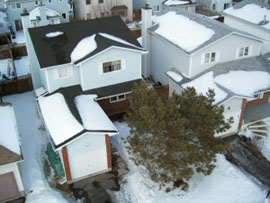
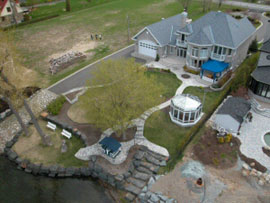
Normally if you want to take aerial photographs of your property for advertising purposes, inspections, etc. you would hire a pilot and rent an airplane (often owned by the pilot) to go out and circle your property. Because of the flight laws and regulations, most pilots can’t get closer than 1000 feet, the lowest allowed fly zone in most cities. They will take a picture of your property as they fly by with a decent zoom and that’s what you get. As you can imagine, hiring a pilot for this can be quite expensive, often well over $1000. They will guarantee you a picture of your property, but remember this is from at least 1000 feet or more so it’s not very detailed.
Another method Yves, the founder of FlyByPictures.com, described to me is that you can take aerial photographs from someone who owns a gas powered RC (Remote Controlled) helicopter. These RC helicopters however also have limitations and restrictions because they are considered gas powered flying vehicles. Although cheaper than hiring a pilot and renting a plane, their still costly because of the price of the helicopters (generally several thousands), the fuel, the maintenance, the skills required to fly them, and especially they are bound by many rules and regulations which limit their photographing abilities.

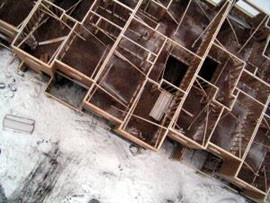
Which leads us to Yves’ company’s new method of aerial photography. What he’s discovered is that people generally want closer images, more detailed, and don’t want to spend as much money, which makes a lot of sense. To do this, he’s taken a battery powered helicopter and modified it to take high resolution photographs as these (I won’t go into the details of his helicopter as these are his trade secrets). The advantage of using this system is multi-fold. First, because of the type of helicopter and modifications it isn’t subject to the rules and regulations of a gas powered RC helicopter. He can fly it up to 300 feet without any issues. Secondly, the costs are much lower than a gas powered RC helicopter. And thirdly, because he can fly closer as well as fly virtually anywhere, he can get some very amazing aerial photographs as you can see in the pictures (as well as with this video of an aerial flyby).
Because of all of these advantages he can offer a superior quality service for a lower price than his competitors. This is great news because it’s now become feasible to use aerial photography for many purposes that were cost prohibitive before. Yves’ informed me that the main intention of his company is to generate pictures for advertising purposes, such as aerial photographs of commercial buildings, golf course pictures of golfing holes, MLS listings to show the full property, flybys of new developments, etc. You can just imagine all the possible applications! It opens up whole new markets!
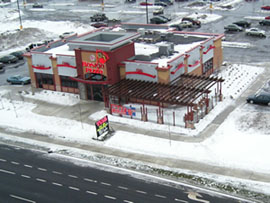
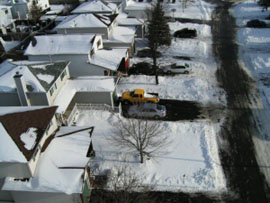
I might make it seem simpler than it is here, but I can tell you Yves definitely put some time learning how to correctly modify and fly his specialty helicopter. I personally saw him maneuver it with ease that seemed like second nature to him, which I’m sure came with a lot of trial and error. The good news is that for us, because of his investments into this new technology, we now have new tools that were before only accessible to richer clients.
All in all I can say I was thoroughly impressed with Yves’ company FlyByPictures.com. I suspect he will get very far and demand will grow quite rapidly.
Permalink to this article Discussions (4)
How to Calculate the Real Estate Market's Overvaluation
I recently had an email discussion with someone about the real estate market and trying to determine when it will be done falling. After thinking about it I realized that although we couldn’t predict when, we will be able to easily figure out how much the real estate market is overvalued when it’s done falling. That is, we will be able to figure out by how much people are overpaying for real estate properties today.
The easiest solution that most people will think of right away is to calculate how much properties drop in price. We can’t do that! It’s completely inaccurate. So how can we really calculate the premium on today’s price? Ignoring inflation for simplification, I’m going to suggest that we can only really calculate that premium by determining how much the monthly mortgage payments drop for the same size of property.
Why can’t we just say that if a property was say $500k, and drops to $400k, that the premium was then $100k, or 20%? Because of the effects of interest rates on real estate prices! As interest rates climb back up, prices have to fall, there’s nothing we can do about that. Therefore if real estate prices fall at exactly the same rate that interest rates climb (a good rule of thumb is that for each percent interest rates climb, real estate prices have to drop by 10% to keep the same monthly payment), then we can say that the market is fairly priced today.
Since I don’t believe that the real estate market is properly priced today, I also think that prices will drop faster than dictated by interest rates. I actually think the real estate market is highly inflated. For example, a general rule of thumb of real estate investing is that your yearly rental income should cover at least 10% of your total purchase price, including renovations, closing costs, etc. This is almost impossible today for the average residential properties. Getting positive cash flow is also almost impossible in today’s market. The market is overpriced, plain and simple.
But just by how much? The key to calculating this is by seeing how much the monthly mortgage payments will drop! Again, if interest rates increase, prices have to drop to keep the same monthly payments. Therefore, if the market is efficient, and the real estate market is correctly priced, we should see little to no difference in the monthly mortgage payments. That is to say prices will only fall in proportion to the interest rate hikes to keep the monthly mortgage payments the same. Cash flow would then also remain where it is.
However, if the real estate market is inefficient and real estate properties are overpriced, then the monthly mortgage payments will drop to bring properties back to profitable levels, to positive cash flow. Therefore prices will have to fall faster than dictated by interest rates alone. If the market is 10% overpriced (assuming no change in interest rates), then we should see monthly mortgage payments drop by 10%.
So for example, if interest rates increase by 3%, then prices have to drop by 30%, nothing new here. However if the market is overpriced by 10% then real estate prices will drop by not only 30% as dictated by interest rates, but by 30% + 10% (the market premium), which means real estate prices will drop by 40%.
As you can see, calculating the premium in today’s real estate market is basically determining how much monthly mortgage payments for a real estate property drop, not how much the purchase price drops.
Permalink to this article Discussions (0)
| « PREVIOUS PAGE | NEXT PAGE » |

